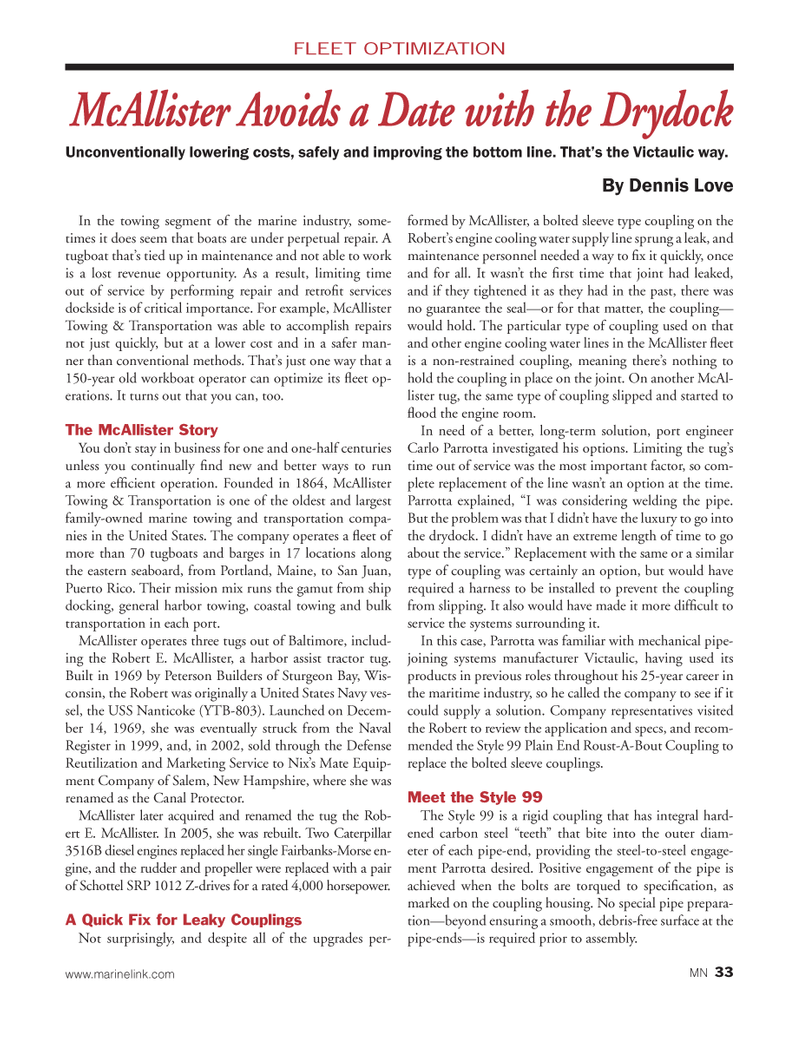
Page 33: of Marine News Magazine (March 2014)
Fleet & Vessel Optimization
Read this page in Pdf, Flash or Html5 edition of March 2014 Marine News Magazine
In the towing segment of the marine industry, some- times it does seem that boats are under perpetual repair. A tugboat that’s tied up in maintenance and not able to work is a lost revenue opportunity. As a result, limiting time out of service by performing repair and retrofi t services dockside is of critical importance. For example, McAllister
Towing & Transportation was able to accomplish repairs not just quickly, but at a lower cost and in a safer man- ner than conventional methods. That’s just one way that a 150-year old workboat operator can optimize its fl eet op- erations. It turns out that you can, too.
The McAllister Story
You don’t stay in business for one and one-half centuries unless you continually fi nd new and better ways to run a more effi cient operation. Founded in 1864, McAllister
Towing & Transportation is one of the oldest and largest family-owned marine towing and transportation compa- nies in the United States. The company operates a fl eet of more than 70 tugboats and barges in 17 locations along the eastern seaboard, from Portland, Maine, to San Juan,
Puerto Rico. Their mission mix runs the gamut from ship docking, general harbor towing, coastal towing and bulk transportation in each port.
McAllister operates three tugs out of Baltimore, includ- ing the Robert E. McAllister, a harbor assist tractor tug.
Built in 1969 by Peterson Builders of Sturgeon Bay, Wis- consin, the Robert was originally a United States Navy ves- sel, the USS Nanticoke (YTB-803). Launched on Decem- ber 14, 1969, she was eventually struck from the Naval
Register in 1999, and, in 2002, sold through the Defense
Reutilization and Marketing Service to Nix’s Mate Equip- ment Company of Salem, New Hampshire, where she was renamed as the Canal Protector.
McAllister later acquired and renamed the tug the Rob- ert E. McAllister. In 2005, she was rebuilt. Two Caterpillar 3516B diesel engines replaced her single Fairbanks-Morse en- gine, and the rudder and propeller were replaced with a pair of Schottel SRP 1012 Z-drives for a rated 4,000 horsepower.
A Quick Fix for Leaky Couplings
Not surprisingly, and despite all of the upgrades per- formed by McAllister, a bolted sleeve type coupling on the
Robert’s engine cooling water supply line sprung a leak, and maintenance personnel needed a way to fi x it quickly, once and for all. It wasn’t the fi rst time that joint had leaked, and if they tightened it as they had in the past, there was no guarantee the seal—or for that matter, the coupling— would hold. The particular type of coupling used on that and other engine cooling water lines in the McAllister fl eet is a non-restrained coupling, meaning there’s nothing to hold the coupling in place on the joint. On another McAl- lister tug, the same type of coupling slipped and started to fl ood the engine room.
In need of a better, long-term solution, port engineer
Carlo Parrotta investigated his options. Limiting the tug’s time out of service was the most important factor, so com- plete replacement of the line wasn’t an option at the time.
Parrotta explained, “I was considering welding the pipe.
But the problem was that I didn’t have the luxury to go into the drydock. I didn’t have an extreme length of time to go about the service.” Replacement with the same or a similar type of coupling was certainly an option, but would have required a harness to be installed to prevent the coupling from slipping. It also would have made it more diffi cult to service the systems surrounding it.
In this case, Parrotta was familiar with mechanical pipe- joining systems manufacturer Victaulic, having used its products in previous roles throughout his 25-year career in the maritime industry, so he called the company to see if it could supply a solution. Company representatives visited the Robert to review the application and specs, and recom- mended the Style 99 Plain End Roust-A-Bout Coupling to replace the bolted sleeve couplings.
Meet the Style 99
The Style 99 is a rigid coupling that has integral hard- ened carbon steel “teeth” that bite into the outer diam- eter of each pipe-end, providing the steel-to-steel engage- ment Parrotta desired. Positive engagement of the pipe is achieved when the bolts are torqued to specifi cation, as marked on the coupling housing. No special pipe prepara- tion—beyond ensuring a smooth, debris-free surface at the pipe-ends—is required prior to assembly.
FLEET OPTIMIZATION
McAllister Avoids a Date with the Drydock
Unconventionally lowering costs, safely and improving the bottom line. That’s the Victaulic way.
By Dennis Love www.marinelink.com MN 33
MN MAR14 Layout 32-49.indd 33 2/21/2014 3:25:28 PM

 32
32

 34
34
